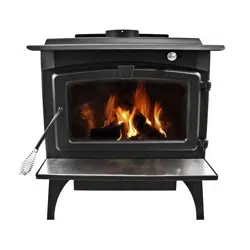Loading ...
Loading ...
Loading ...

13
Chimney Height / Rise and Run
This product was designed for and tested on a 6 inch
(152mm) chimney, 14 to 16 feet (420-480cm) high,
(includes stove height) measured from the base of the
appliance. The further your stack height or diameter varies
from this configuration, the possibility of performance
problems exists. Chimney height may need to be increased
by 2% per each 1000 feet above sea level. It is not recom-
mended to use offsets or elbows at altitudes above 4000
feet above sea level or when there are other factors that
affect flue draft.
INSTALLING CHIMNEY COMPONENTS
Chimney Connector
Single wall connector or stove pipe.
This must be at least 24 gauge mild steel. The sections
must be attached to the appliance and to each other with
the crimped (male) end pointing toward the stove. All
joints, including the connection at the flue collar, should be
secured with sheet metal screws. Make sure to follow the
minimum clearances to combustibles. Where passage
through the wall, or partition of combustible construction
is desired in Canada, the installation shall conform to CAN/
CSA-B365.
Chimney Termination Requirements
Follow manufacturer’s instructions for clearance,
securing flashing and terminating the chimney.
• Must have an approved and listed cap
• Must not be located where it will become plugged
by snow or other material
• Must terminate at least feet (91cm) above the roof
and at least 2 feet (61cm) above any portion of the
roof within 10 feet (05cm).
• Must be located away from trees or other structures
2-10-3 Rule
These are safety requirements and are not meant to
assure proper flue draft.
OPERATION
Do not use a grate or elevate fire. Build wood fire directly
on hearth. When the stove is used for the first time the
solvents in the paint will smoke off.
WOOD
This heater is designed to burn natural wood only. Higher
efficiency and lower emissions generally result when
burning air dried seasoned hardwood, as compared to
softwood or to green or freshly cut hardwood. Only use
dry seasoned wood. Green wood, besides burning at only
60 percent of the fuel value of dry wood, deposits creosote
on the inside of your stove and along the chimney. This
can cause an extreme danger of chimney fire. To be called
seasoned, wood must be dried for a year. Regardless
of whether the wood is green or seasoned, it should be
stored in a well-sheltered, ventilated area to allow proper
drying during the year to come. Wood should be stored
beyond recommended clearance from combustibles.
DO NOT BURN:
• Treated Wood • Solvents • Trash • Coal
• Garbage • Cardboard • Coloured Papers
INSTRUCTIONS FOR FIRST BURN - CURING THE
STOVE PAINT
Your stove has been painted with the highest quality
stove paint and has special break-in procedures. The
heat generated by the normal operation of the stove, will
serve to harden the paint.Ventilate the house during the
first three times the stove is used. The paint on the stove
will give off smoke, carbon dioxide and an odor. Without
adequate ventilation, concentrations of smoke could
irritate you or cause damage to person and/or property.
Open doors and windows and use a fan if necessary.
After the initial burns, the paint will be cured and there
should be no more smoke.
Each of the initial burns should be conducted as follows:
1. The first and second burns should be at approximately
250 deg F (120 deg C) for approximately 20 minutes.
2. The third burn should be between 500 deg F (260 to
370 deg C) for at least 45 minutes. The important
fact is the paint should be cured slowly. Avoid hot
fires during the curing process. During the curing
process the paint will be gummy. Once cured the
paint will remain hard. It is normal to see flat spots
on painted surfaces of the stove. The flat spots on
the paint surface indicate the hotter surfaces of the
stove, and is caused by the heat radiating through the
paint. It is also expected that shiny spots caused by
friction from the packaging materials, will disappear
during the curing of the stove.
SO:
1. Remember to Ventilate well.
2. Allow the stove to cure before burning for long
periods at high temperatures.
3. Flat spots on the painted surfaces are normal.
4. Shiny spots on the paint surface before burning is nomal.
5. Call your dealer if you have any questions.
Loading ...
Loading ...
Loading ...
